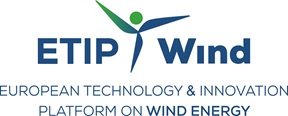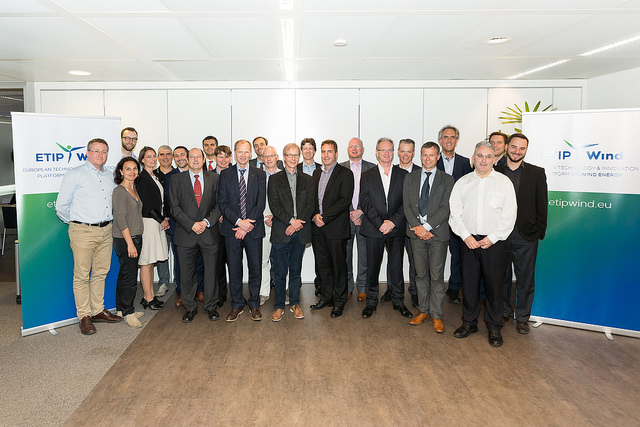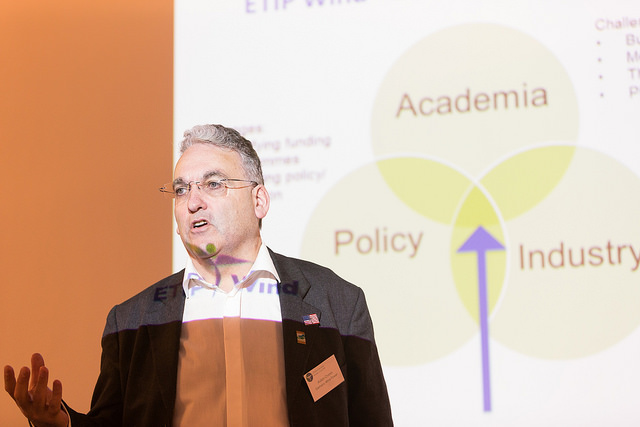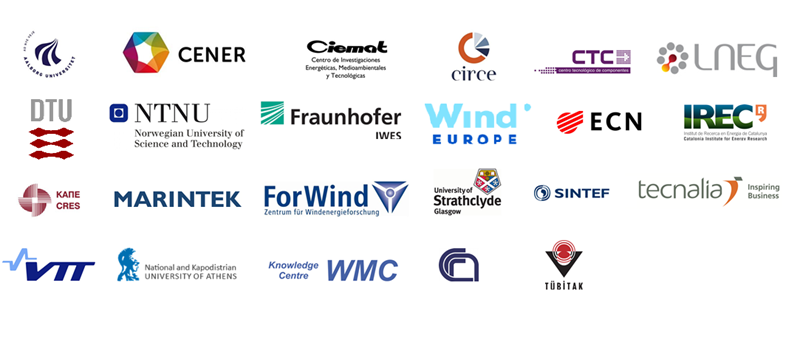This is the fifth bi-annual newsletter for the EERA Joint Programme on Wind Energy (EERA JP Wind) after EERA JP Wind has successfully acquired the EU funded IRPWind project.
Feel free to distribute the newsletter among your colleagues and friends!
On May 26th the IRPWind project had a second review meeting in Brussels, as it has now passed the halfway mark. All activities are generally on track and I am overall very satisfied with the progress done. There are, however, some challenges in building a truly integrated European research programme for wind energy. Above all, the coordination within and between countries is not easy and the absence of the Technology Platform for Wind (TPWind) since 2014 has made the collaboration with our colleagues in the industry more difficult. But now there are initiatives to address these issues.
The European Technology and Innovation Platform on Wind - ETIPWind started its operations in January 2016 and is now in the process of preparing a new Strategic Research Agenda to be presented at EWEA2016 in Hamburg later this year.
The link between EERA and the new Technology Platform was discussed at the IRPWind General Assembly on April 28th in Copenhagen, where Kristian Ruby (Chief Policy Officer at WindEurope) presented ETIPWind structure and EERA involvement in it. The European Energy Research Alliance has 8 members in the Steering Committee who are sitting together with 16 industry representatives.
At the ETIPWind Steering Committee meeting on June 2nd it was agreed that EERA JPWind will comment and contribute to the preparations of the ETIPWind Strategic Research Agenda (SRA), since the current priorities outlined by ETIPWind are very much defined by the ETIPWind Advisory Group. However, the ETIPWind is working under a very tight deadline as the SRA will be presented in Hamburg in late September.
The Joint Programme Wind - JPWind Steering Committee meeting was organized in the same venue the day before, April 27th. The main outcome of the meeting is the development of a more comprehensive database of national and European wind energy research projects. The database will significantly help identifying and linking up research areas across Europe.
Another highlight of the meeting is the election of Arno van Wingerde (Fraunhofer IWES) as Sub-Programme (SP) Coordinator for structures and materials, after Denja Lekou had to step down. I want to thank Denja for her big contribution to JPWind and welcome Arno in his new role.
On another note, on June 8th and 9th several members of the JPWind management board attended a two-day workshop in Washington organised in collaboration with the DOE and the European Commission. I was very happy to see Dr. Lynn Orr, the US Under-Secretary for Science and Energy, delivering the opening speech; it was a clear statement from the US about the value of strengthening collaboration in the wind energy sector between the US and Europe. The European Commission will host a return workshop before the end of the year.
Peter Hauge Madsen, DTU
Mattias Andersson, DTU
2. EERA JP Wind news
New JP Wind Members have been elected
As mentioned in the introduction, on 27 April 2016 EERA JP Wind held its 11th Steering Committee (SC) Meeting. The meeting took place at the UN City in Copenhagen, a scenic venue located at the city’s waterfront with a view to the Middelgrund windfarm - one of the first community owned offshore wind farm.
An important topic was the approval of the new applicants to EERA JP WIND – a discussion that has already started during the SC meeting in Paris in Autumn 2015, where the review on the following applicants was presented:
- TNO (review presented by Peter Eecen, ECN)
- NTUA (review presented by Nikos Stefanatos, CRES)
- University College Cork (review presented by Xabier Munduarte, CENER)
The Steering Committee formally approved the three institutions as members of JP Wind and warmly welcomed them.
Peter Hauge Madsen, DTU
Have you missed the ETIPWind workshop on Friday 3 June?
The European Technology and Innovation Platform for Wind (ETIPWind) has started its operations in January 2016. ETIPWind connects Europe’s wind energy community. The platform involves key stakeholders from the wind energy industry as well as policy and research institutes and aims at positioning wind energy as a strategic industrial sector.
|
 |
ETIPWind started the ambitious task of updating the Strategic Research Agenda from 2014.
The ETIPWind Steering Committee has decided to do this through various steps:
- Data collection /February - March, 2016
- Online stakeholders survey /April - May, 2016
- Expert interviews /April - May, 2016
- Gap analysis validation /June 3, 2016
- Workshop gathering input into the Horizon2020 /June 3, 2016
Energy Work Programme 2018-2020
- Launch of the Strategic Reseach agenda 2016 /September, 2016
The first five steps are now completed. The WindEurope analysts have performed a significant work of data collection to see what wind energy-related topics were missing in past research. They went through more than 2,700 reports and conference documents. The online stakeholders’ survey received more than 230 responses from industry and academia and several experts have been interviewed individually for approximately 45 minutes.

Group picture, ETIPWind representatives in Brussels
On Friday 3 June a validation meeting took place in Brussels, where the results of this gap analysis were presented to the wind energy community. A discussion on which research priorities should be in the 2016 Strategic Research Agenda took place. The consolidated paper is being approved by the ETIPWind Steering Committee and will be available on the ETIPWind website in mid-July.
Worth noting is that 8 EERA representatives are sitting in the Platform’s Steering Committee, representing the views of the European research community.
More information on the next events is available here. Should you have any questions, do not hesitate to contact the ETIPWind Secretariat.
Diletta Zeni, WindEurope

ETIPWind Steering Committee chair - Aidan Cronin, Advisory Specialist, Technical Advisory, Siemens Wind Power A/S
|
Sub-programme evaluation
EERA JP Wind has initiated a review process to evaluate each of the sub-programmes. The purpose of the evaluation is to ensure that the SPs are performing adequately and that they respond to EERA principles and strategy. The involvement of SP members will be evaluated as well.
|
 |
The process will focus on the following aspects:
- Added value
- Joint activities versus individual activities
- Impact
The reviewers will look for alignment of activities with short-, mid-, and long-term planning. Furthermore, the national strategy of the SP members must be in line with the overall SP strategy. Lastly, transfer of knowledge and existing project results have to form the basis of new research efforts.
Effectiveness is measured by logging KPIs, after which an evaluation report will be presented to the EERA JP Wind management board, along with potential recommendations for improvement. The Management Board will finally conclude on any further actions required and a timeline.
The evaluation process will be repeated on a regular interval to ensure effectiveness.
Ignacio Marti – ORE Catapult
3. EERA JP Wind Sub-Programme (SP) news
|
New SP coordinator
A new coordinator of the EERA JP Wind Sub-Programme Structures and Materials has been nominated, since Denja Lekou has left CRES and the JPWIND Management Board. Four candidates have shown interest in coordinating the Sub Programme. During the last JP Wind Steering Committee meeting an election among these 4 volunteers took place.
Arno van Wingerde (Fraunhofer IWES) received most votes. Arno will complete the term of the current JP Management Board, i.e. 2014-2018. EERA JP WIND Sub Programmes are currently under evaluation and might change in scope and numbers at the beginning of 2017.
|

Arno van Wingerde, Fraunhofer IWES
|
Christian Orup Damgaard, DTU
White Paper on Wind Energy and Society
The sub-programme on Economics and Social Aspects of Wind Integration (SP7) has produced a white paper focusing on the social aspects on wind energy. The primary goal is to gain a better understanding of the mechanisms and processes related to effective local siting of wind power and lessons learned from other areas that may avoid conflicts and possibly reduce uncertainties in project lead times and development costs.
The public and institutions (whether government or non-governmental) have raised issues and questions relating to the potential risks posed by wind and the acceptability of this renewable energy in towns and cities across the European Union. Why is a renewable energy technology fuelling opposition movements? How can the social sciences help address these challenges? Are national actors and politicians willing to reach into local communities to engage citizens in a democratic process?
There is substantial uncertainty across the communities about how we will navigate into the future. The white book is a first stage of a strategy that is still to be developed in order to gain a deeper understanding of the scope of these issues and how to address selected priorities by a review of the literature and a dialogue with experts across disciplines.
The white book will be made available online.
Klaus Skytte, DTU
4. IRPWind News
Infrastructures: joint experiment (Work package 3)
The Research Infrastructures work-package (WP3) has launched on February 2016 the First Call for Joint Experiments. This call was open for all partners of the IRPWIND project and EERA JP WIND members as well. The related information and necessary documents to apply for joint experiments was uploaded on the IRPWind website. Prior to the call a Technical Committee was assigned to the final approval of the selected joint experiments and three networks were created, so that the experiments would focus in the following areas:
1. Wind Tunnel test
2. Field Wind Turbine Experiment
3. Grid Integration.
As a result of this process, three proposals have been awarded with a grant. Those are:
1. “ScanFlow” – the leader of the proposal is DTU and this joint experiment falls into the Research Wind Turbine network
2. “Experimental validation of high definition modular multilevel converter” – the leader of the proposal is SINTEF and this joint experiment falls into the Grid Integration network
3. “L4WT: Lidars for Wind Tunnels” - the leader of the proposal is DTU and this joint experiment falls into the Wind Tunnel network.
The first results will be presented at the IRPWind conference 2016 in Amsterdam (September).
Antonio Ugarte, CENER
Transfer of knowledge: the IRPWind conference 2016 (Work package 4)
The draft-programme of the IRPWind conference 2016, happening in Amsterdam on the 19th and 20th of September, has been uploaded to the website.
Last year’s edition of the conference has received very good feedback and has led to further improvement of the planning and composition of the programme.
An official invitation will be sent before Friday June 10th. Please save the date!
Martijn van Roermund, ECN
Mobility: continuous call (Work package 5)
Following discussions with many EERA JP Wind colleagues, a new pilot scheme for mobility grants has been launched. The scheme is now open to all scientists working in EERA JP Wind member organizations and the call is continuous.
Visit the IRPWind dedicated page to learn more about the rules and be inspired by the testimonial videos of colleagues that have taken advantage of this unique opportunity.
Anna Maria Sempreviva, DTU
Design of offshore wind farms: an update (Work package 6)
As of May 2016 the ‘Design of offshore wind farms’ work-package has managed to secure access to data from the MARINTEK experiment and the Blyth wind farm. The MARINTEK floating wind turbine model together with the measurements from the 2MW, 66m, V66 VESTAS wind turbine (monopole and bottom-fixed) will be used to further develop models for offshore wind turbines. The benchmarking exercises that are scheduled to commence in the next month will serve for both finding weaknesses in current approaches (thus providing targets for future research), as well as validating the improvements implemented during the IRPWind project.
Pawel Gancarski, CENER
IRPWind LinkedIn group
Join the IRPWind LinkedIn group for updates on the EERA JP Wind news, project results and wind-related events.
The community has grown to 150 members already!

5. Suggestions and feedback?
If you have any topic suggestions for the next newsletter, or if you have ideas on how to improve it, feel free to send your input to Martijn van Roermund.
You can subscribe and unsubscribe at IRPWind website.
